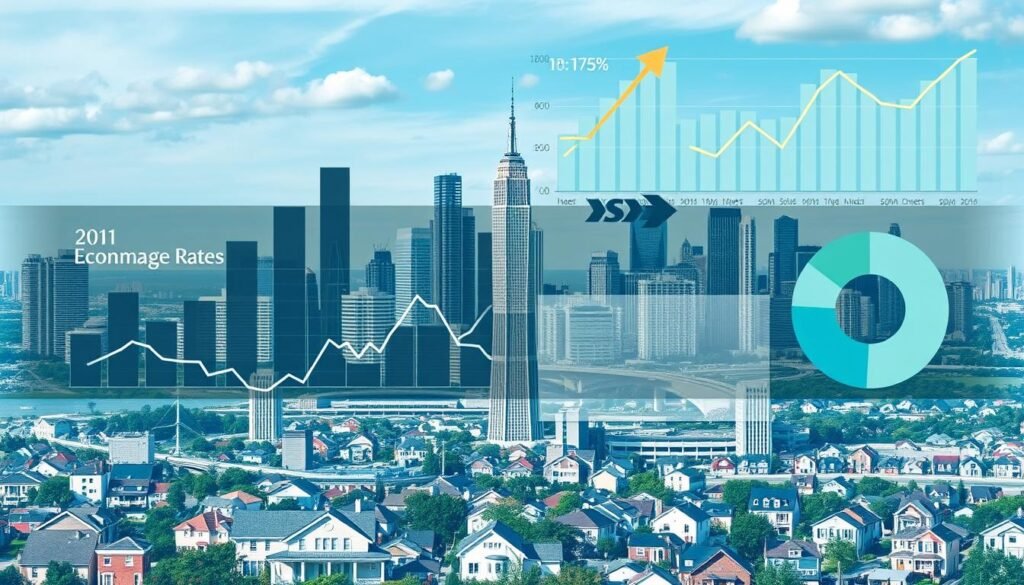Mortgage Rates Edge Up to Match 4-Month High

Mortgage rates have gone up, hitting a four-month high. This is big news for homeowners and people looking to buy homes. Knowing about these changes is very important.
Big banks have shown us this rate increase. It's a big change in the real estate and finance world.
Key Takeaways
- Mortgage rates have reached a four-month high as per the Federal Housing Finance Agency.
- Understanding recent mortgage trend analysis is essential for homeowners and homebuyers.
- Financial market insights indicate a notable shift in the real estate finance landscape.
- The latest mortgage rate developments are impacting home financing decisions nationwide.
- Historical data from major financial institutions highlights the significance of this rate increase.
Current Mortgage Interest Rates
Understanding mortgage interest rates is complex. It involves looking at many factors. We compare recent trends to past months and see how rates vary by region.
Economic experts, Realtors, and national banks share their insights. This gives us a full picture of the changing rates.
Factors Influencing Mortgage Rates
Many mortgage rate determinants affect current rates. Key factors include:
- Economic Growth: A strong economy means higher interest rates.
- Inflation: When inflation rises, so do mortgage rates. This is because lenders adjust for the loss of buying power over time.
- Federal Reserve Policies: The Federal Reserve's decisions on interest rates greatly impact mortgage rates.
- Global Events: International political and economic events can affect investor confidence and interest rates.
Comparison with Previous Months
Looking at month-over-month interest rate analysis shows interesting trends. Recent months' data shows how rates have changed:
| Month | Interest Rate |
|---|---|
| January | 3.2% |
| February | 3.4% |
| March | 3.6% |
| April | 3.5% |
| May | 3.7% |
Regional Variations in Mortgage Rates
Looking at mortgage rate geographic trends helps us understand regional differences. Realtors' associations and national banks provide data. This shows how rates vary:
- Northeast: Rates are often higher here. This is because of the dense population and high demand for housing.
- South: Rates are generally lower. This is due to lower living costs and regional economic conditions.
- Midwest: Rates are in the middle. This reflects balanced demand and steady economic growth.
- West: Rates vary widely. This is because of diverse economic conditions and housing demand.
Impact on Housing Finance
Mortgage rates going up changes how we finance homes. It makes loans more expensive and affects how many people apply for them. Looking at real data and expert views shows how big this change is.

Changes in Loan Costs
Higher mortgage rates mean more expensive loans. Financial advisors say this leads to bigger monthly payments. This makes long-term loans less affordable for many.
Buyers then have to rethink their plans. They might choose shorter loans or pay more upfront.
Effect on New Loan Applications
More expensive mortgage rates also mean fewer loan applications. Housing finance reports show a drop in new applications when rates rise. This shows people are less willing to take on costly loans.
This trend affects not just families but the whole market. It changes how lenders work and what they predict financially.
| Loan Aspect | Before Rate Increase | After Rate Increase |
|---|---|---|
| Average Loan Cost | $250,000 | $270,000 |
| New Loan Applications | 500,000 | 420,000 |
| Monthly Payment | $1,200 | $1,350 |
This table shows how mortgage rate changes affect housing finance. It's key for lenders and borrowers to understand these shifts in the housing market.
Real Estate Market Trends
Mortgage rates have changed a lot lately. This housing market analysis looks at how these changes affect property value trends and buyer's market dynamics. Reports from the National Association of Realtors show that property values change with higher borrowing costs.
When mortgage rates go up, buyers change their plans. This affects the demand and supply in the market. Experts say that sellers might have more power too. Here's what's happening now, based on what experts say:
| Region | Property Value Trends | Buyer's Market Dynamics |
|---|---|---|
| North East | Stable with slight increase | More properties available, increased negotiation power |
| Midwest | Mild depreciation | Slightly fewer buyers, enhanced seller competition |
| South | Moderate appreciation | High demand sustaining property values |
| West | Marked volatility | Dynamic shifts, dependent on local economic indicators |
Looking at these numbers, we see big differences in the housing market. Changes in property value trends and how buyers act are key. Experts say we need to watch these closely to make smart choices.
Economic Indicators Linked to Mortgage Rates
Knowing the economic health indicators that affect mortgage rates is key. Inflation rates and the Federal Reserve's policies are very important.

Inflation Rates
Inflation directly affects inflation and mortgage correlation. When inflation is high, mortgage rates go up too. This is because lenders want to make more money than the inflation rate.
The Bureau of Labor Statistics gives us data on inflation. This data shows how prices change. It shows how mortgage rates can go up when prices rise.
Federal Reserve Policies
The Federal Reserve's Fed rate decisions are very important for mortgage rates. When the Fed changes interest rates, it affects mortgage rates. This is because the Fed controls the economy and inflation.
The Fed's announcements can tell us when mortgage rates might change. These decisions help keep the financial markets stable. They also help us guess when mortgage rates might go up or down.
| Economic Health Indicator | Impact on Mortgage Rates |
|---|---|
| Inflation Rate | Higher inflation typically leads to higher mortgage rates |
| Fed Rate Decisions | Adjustments in benchmark interest rates influence mortgage rate trends |
Adjusting Borrowing Strategies Amid Rising Rates
Homeowners are looking at new ways to handle their money as mortgage rates go up. Strategic mortgage planning is key to managing money well. Looking into refinancing and knowing the difference between fixed and adjustable rates can save a lot of money.
Refinancing Opportunities
Refinancing is a good choice for many homeowners. It lets them take advantage of lower interest rates. By refinancing, they can pay less each month and save on interest.
With smart planning, they can also get money for home improvements or to pay off debt.
Fixed-rate vs. Adjustable-rate Mortgages
It's important to know the good and bad of fixed and adjustable mortgages. A mortgage type comparison shows fixed rates are steady, while adjustable rates can change.
| Fixed-rate Mortgages | Adjustable-rate Mortgages | |
|---|---|---|
| Interest Rates | Stable and predictable over the loan term | Initial lower rates with potential future adjustments |
| Monthly Payments | Consistent payments, facilitating long-term budgeting | Lower initial payments that may increase after adjustment periods |
| Suitability | Ideal for risk-averse borrowers planning to stay for the long term | Beneficial for borrowers expecting to move or refinance before rate adjustments |
Homeowners can make smart choices with advice from experts. They can pick the best mortgage for their future. This can lead to big savings and protect against financial risks.
Mortgage Rates Edge Up to Match 4-Month High
Mortgage rates have changed a lot lately. They've reached levels not seen in four months. It's important to look at the past and guess what will happen next.
Historical Context
Mortgage rates have followed a pattern over the years. This pattern is influenced by many economic factors. Looking at the past, we can learn a lot.
Groups like Freddie Mac and the Federal Housing Finance Agency have tracked these changes. They show us how rates have moved.
| Year | Average Rate | Key Economic Events |
|---|---|---|
| 2018 | 4.54% | Federal Reserve Rate Hikes |
| 2020 | 3.11% | COVID-19 Pandemic Impact |
| 2022 | 5.00% | Post-Pandemic Recovery |
This table shows how big events affect mortgage rates. Rates go up when the economy grows and down when it's unsure.
Expected Future Trends
Experts think mortgage rates will keep changing. They say rates might not move much soon but could go up later. This could happen if the Federal Reserve changes its plans or if inflation grows.
Financial news agrees with these ideas. It suggests being careful but informed for those looking to buy a home or invest.
Challenges to Homebuyer Affordability
The affordability crisis is really tough for people wanting to buy homes. Mortgage rates are making it hard, especially for first-time buyers. The housing affordability index shows fewer people can get mortgages they can afford.
Households are feeling the pinch more than ever. Higher mortgage rates mean bigger monthly payments. This makes buying a home hard for many, especially young people and those with low incomes.
Reports show these groups face big challenges. Millennials are seeing their chances of owning a home drop. The crisis is making many wait to buy a home.
Experts agree with these findings. Higher mortgage rates and not enough wage growth make it tough for buyers. We need to fix these issues to help more people own homes.
| Year | Mortgage Rate (%) | Affordability Index |
|---|---|---|
| 2020 | 3.5 | 150 |
| 2021 | 3.75 | 140 |
| 2022 | 4.0 | 130 |
| 2023 | 5.0 | 120 |
Conclusion
In the last few months, mortgage rates have gone up. This is the highest they've been in four months. It affects both current and future homeowners a lot.
The cost of loans and new loan applications have changed. Also, mortgage rates vary by region. This makes it important to understand the local market.
Economic factors like inflation and Federal Reserve actions have shaped borrowing costs. With inflation still high, getting good financial advice is key. The real estate market keeps changing, influenced by trends and rules.
People thinking about buying should look at refinancing options. They should also think about fixed-rate versus adjustable-rate mortgages. This helps them make smart choices.
The future of lending looks hopeful but careful. Knowing the past helps predict what might happen next. It's important to stay ready for changes.
Experts say to be proactive. This means all borrowers and investors should get ready for the changing mortgage world.





